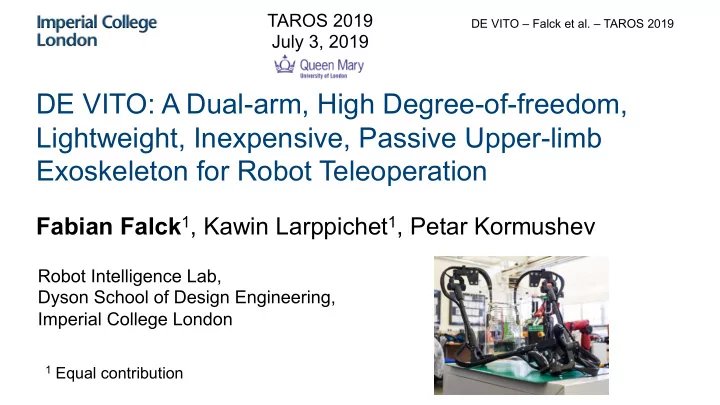

TAROS 2019 DE VITO – Falck et al. – TAROS 2019 July 3, 2019 DE VITO: A Dual-arm, High Degree-of-freedom, Lightweight, Inexpensive, Passive Upper-limb Exoskeleton for Robot Teleoperation Fabian Falck 1 , Kawin Larppichet 1 , Petar Kormushev Robot Intelligence Lab, Dyson School of Design Engineering, Imperial College London 1 Equal contribution
DE VITO – Falck et al. – TAROS 2019 Motivation • Major advances in autonomous robot perception, planning and control in recent decades • Super-human hardware • Sensors (3D LIDAR, 360-degree vision) vs. • Actuators (AC servo, hydraulic motor) • Yet, the vast majority of human tasks in dynamic, unstructured environments far from being executed autonomously • à Teleoperation as a realistic, complementary transition solution, combined Vision (often) Reality with reliability and precision of autonomy
DE VITO – Falck et al. – TAROS 2019 Exoskeletons – Related work Semi-circular bearing Four-bar linkage Key disadvantages of previous designs: • Complicated design (large number of (moving) parts) à high material cost • Bulky, heavy design (> 10 kg) Three non-90- Figure 3 : comparison of internal rotation measurement mechanism. Semi-circular Our work guideway (top left) [4], Four-bars linkages (top right) ADDIN degree linkage RW.CITE{{doc:5b9b02cde4b09ad10da468e0 EvanAckerman 2017}}[20], three none-90-degree linkage (bottom left)[21], offset linkage (bottom right)
DE VITO – Falck et al. – TAROS 2019 DE VITO 1 - Design Key features: • Dual-arm upper-limb exoskeleton • 7 DOFs • Passive measurement • Light-weight (~5x lighter than related work) • Simplistic (mostly 3D printed) • Energy-efficient • Total material cost (at least 10x less than related work) 1 Design Engineering's Virtual Interface for TeleOperation Figure 2 : CAD model of the exoskeleton
DE VITO – Falck et al. – TAROS 2019 Human arm motion and coverage + 2 3 1 - 0 - + - + 0 0 4 5 6 0 0 7 + - - + + + - - 0 Anatomic Joint description and Motion description Human arm Exoskeleton Coverage per- part type RoM [deg.] RoM [deg.] centage [%] Figure SEQ Figure \* ARABIC 1 : Human arm motion ADDIN Glenohumeral joint Flexion/Extension (158,53) (110,55) 78 RW.CITE{{doc:5a94859ee4b06ab1c08d3613 [NoInformation] 2015}}[15] (ball and socket Shoulder Adduction/Abduction (0,170) (0,110) 64 joint) Medial/Lateral rotation (70,90) (110,110) 100 Elbow Elbow joint (hinge Flexion/Extension (146,0) (110,110) 75 joint) Forearm Radioulnar joint Pronation/Supination (71,84) (110,110) 100 (pivot joint) Wrist joint (saddle Flexion/Extension (73,71) (110,55) 88 Wrist joint) Adduction/Abduction (33,19) (25,180) 100
DE VITO – Falck et al. – TAROS 2019 Design variants and Singularities (right arm) A Singularity pose: C A Upper Arm forwards B Upper Arm outwards B C Upper Arm downwards à “relaxed position” à chosen variant
DE VITO – Falck et al. – TAROS 2019 Chosen design specification • 3D printed joints and mounts • Carbon rod linkages Z 0,1 • Total weight: 3.2 kg X 0,1 • Weight of each arm: 0.85 kg • Total material cost: ~200 GBP Z 2 Index i a i α i d i θ i 1 0 0 0 θ 1 2 0 π 0 θ 2 Z 3 2 upper linkage Z 4 3 0 π 0.37 θ 3 2 4 0 − π 0 θ 4 2 5 0 π 0.33 θ 5 2 6 0 − π − 0 . 07 θ 6 Z 6 2 lower linkage Z 5 Z 7 7 0 π − 0 . 07 θ 7 2
DE VITO – Falck et al. – TAROS 2019 Lower arm and Nunchuk controller Open/close the gripper Open/close the gripper Z Z Z Z C C Emergency stop C C Emergency stop Fine manipulation Fine manipulation (pitch and yaw) (pitch and yaw) L R L R Figure 5 : Wrist joint design and end-effector controller Figure 12 : buttons mapping of both right and left Nunchuk controller Figure 5 : Wrist joint design and end-effector controller Figure 12 : buttons mapping of both right and left Nunchuk controller
DE VITO – Falck et al. – TAROS 2019 Electronic components and communication Circuit board body and wiring diagram: • ROS node for communication • Arduino mega between master and slave • Potentiometers
DE VITO – Falck et al. – TAROS 2019 Kinematic mapping algorithms 1) Joint space one-to-one mapping: 3) Cartesian space mapping: + θ o ff set θ slave = θ master P slave end-e ff ector = P master end-e ff ector + d o ff set i i i Two modes for arbitrary seventh DOF: 2) Joint space scaled mapping: 1 2 + θ o ff set θ slave = c i ∗ θ master i i i Subsequent inverse kinematics solving Figure 11 : Cartesian mapping example Horizontal gripping posture (top), Vertical gripping posture (bottom)
DE VITO – Falck et al. – TAROS 2019 Qualitative experiments on Robot DE NIRO Figure 14 : Setup of the Brick stacking experiment
DE VITO – Falck et al. – TAROS 2019 Conclusion and Future work • DE VITO, a dual-arm upper limb • Refinement of kinematic exoskeleton teleoperating Robot DE control algorithms NIRO on various manipulation tasks • Further qualitative and • Mechanical and electronics design, quantitative validation of kinematic mapping and experiments design CAD models, documentation, code, videos at: http://www.imperial.ac.uk/robot-intelligence/robots/de_vito/
Recommend
More recommend